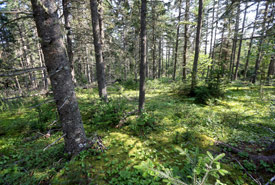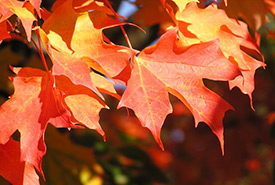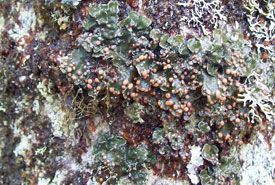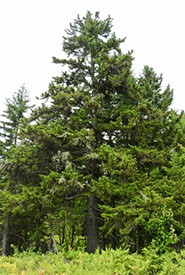Canada’s other rainforest

Wabanaki (Acadian) forest, Chignecto Isthmus, NS (Photo by Mike Dembeck)
The word “rainforest” evokes vivid images of a rich natural world. Many people think of the lush, misty jungles of the Amazon or Congo with thick vegetation. If you live in Canada, you might think about BC’s temperate rainforests, with towering Douglas-fir, Sitka spruce and western red cedar. You might even know about the pockets of rainforest hidden in central BC in places like the Nature Conservancy of Canada’s (NCC’S) Darkwoods property. Here, westward-moving clouds are forced to release their moisture as rain and snow as they cross the Rocky Mountains. These inland rainforests share many of the same tree species as their coastal cousins, but rarely reach the same age due to more frequent fires, insect outbreaks and avalanches.
But there are other rainforests in Canada where you can find ancient trees shrouded with lichen and mist. But these old trees are almost gone. And you need to travel to Canada’s other coast to find them.
Just like the forests along Canada’s Pacific coast, the forests of Atlantic Canada’s coast are strongly influenced by the ocean. The Atlantic coast has cooler summers and warmer winters than inland areas, more abundant rain and snowfall, and is often shrouded in fog. Many communities along the East Coast, including Halifax, have more total precipitation, including more rainfall, each year than Vancouver.

Sugar maple (Photo by Liz West)
All this rain has a profound impact on the forests that grow here. Nova Scotia, Prince Edward Island and New Brunswick are part of the Acadia forest region. They have a rich diversity of trees, including yellow birch, red spruce, American beech and sugar maple. Although poorly documented, early accounts suggest that about half of these Acadian forests were dominated by big, old trees. Fires and other large-scale disturbances were rare. When a big tree could no longer bear its 10 tonnes of trunk, stems and leaves, it would crash down, opening a gap in the forest canopy that younger trees eagerly filled.
Some of the forests right along the coast are an exception. These coastal forests are dominated by black spruce and balsam fir, with scattered red maple and white birch, and must face the ocean head-on. Constant wind and salt spray make this a challenging place to be a tree. As a result, these spruce and fir are often stunted and rarely live more than a century.
Related blog posts
The old-growth forests of the Maritimes support many species of wildlife, including screech owl and wood duck, which need large trees to find nesting cavities. Old-growth forests also provide habitat for endangered species. The humid old-growth rainforests of Canada’s Atlantic coast are one of the last places left in the world where the boreal felt lichen has a chance to avoid extinction.

Boreal felt lichen (Photo by Ian Goudie/Wikimedia Commons)
Perhaps Canada’s eastern rainforests are not as well known because the trees are smaller than BC’s giants. A Douglas-fir can grow to 85 metres tall along the BC's coast and 42 metres tall in the interior, commonly living to be over 500 years old.
The East Coast counterparts are hardly shrubs by comparison, though. Eastern hemlock and red spruce that are more than 400 years old have been documented in Nova Scotia and New Brunswick. Many long-lived hardwoods, such as sugar maple and yellow birch, can grow to the height of a seven-storey building, and eastern white pine can grow almost twice as tall — up to 35 metres.
Or perhaps, the words “rain” and “forest” have lost their connection on Canada’s East Coast because much of the old-growth has been lost. This region has a long history of settlement. Most of these forests have been harvested several times, and less than one per cent of original old-growth remains. Our Acadian forests remain grand in scale, with vast areas of Nova Scotia and New Brunswick still covered by trees, but diminished in character and diversity.

Red spruce (Photo by jlmason, iNaturalist, CC BY-NC 4.0)
There are signs that this will be the low point that future generations will look back on to measure their conservation progress. The value of keeping and restoring old-growth forests is being increasingly recognized in Canada and around the world. In addition to protecting rare species and other wildlife, they help filter drinking water, buffer communities from flooding and have immeasurable recreational and spiritual value for many people.
How we perceive nature affects how we conserve it. There is certainly splendour in the rainforests of Canada’s west. It’s hard to miss. Big, old trees that challenge us to decide what we will choose to pass on to future generations. But there is also splendour in the rainforests of Canada’s other coast in the pockets we’ve left behind and the protected places where future generations will one day walk through ancient forests. For places like this, where the land has been altered, we also have a choice. We can choose the forests that we aspire to protect and restore for future generations.
Dan Kraus is one of the speakers at the 2019 NatureTalks Cross-Country Speaker Series. To learn more about NatureTalks and to book your tickets, click here.


